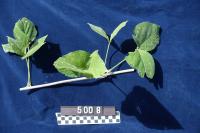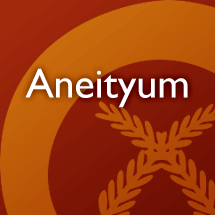Entry # 2988 has returned 1 entry
inyacelcou

n. vine running many meters long over clay soil and grassy area on hillside where the triangular wooden signs are that used to be a landmark for ships coming to the island. Sterile. (collection: Michael J. Balick #5008)
Example: This plant is the focus of an important legend on Aneityum. When the missionary John Geddie and colleaguse first arrived on the island in July of 1848, the Chiefs welcomed them but some of the people did not like the idea. So these people sent a basket containing a peeled coconut and a fish (nopom) to the Chief in Umej to ask him to support the idea of getting rid of the missionary that the Chief of Analcahuat had welcomed. If the Chief of Umej were to eat the fish and coconut meat, it would mean that he agreed with the opposition. The Chief refused to eat the food in the basket and he told the people a parable involving this plant. A person cannot find the tip of the stem or the end of the root in the ground. So if they were to eliminate the missionary, his activity would continue because of God’s power. As it is with this plant, it will continue to grow and flourish if you cut it or try to dig up the root. So he sent a message about this plant to the people in Analcahuat who objected to the presence of the missionary stating this parable. Those people in Analcauhat held a secret meeting and they chose a powerful and strong person to kill the missionary. During the night the person went to the missionary’s house while he was in the toilet. Returning to the house, the missionary found the person in his doorway, and that person lifted his club to strike the missionary. But at that point the attacker’s hands suddenly had no power and the club fell from his hands, and he fell over. The missionary told him to get up, and not come back. After that experience, the people of Umej realized that God’s power was great and they could not go against it. The Chief took the peeled coconut that was sent him and covered it with the skin of another coconut and planted it instead of eating it. This coconut grew and the missionary’s work continued to grow on the island. So this vine played an important role in communicating the power of God to the people of Aneityum.
bookmark


